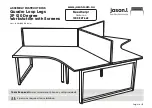6.3.9
Liquid Crystal
Display
Chapter 6 - Detailed Diagnostics
continued
The microprocessor PCB is screwed to four stand-offs on top of the generator PCB. It is connected to J2 and J4 on
the generator PCB. For a functional description see section 2.2.
The simplest way to determine if the microprocessor PCB is working is by substitution. However, the following
tests may be performed if preferred.
In order to test the microprocessor PCB, it must be re-oriented in the service position. If this is not already done,
with the line cord removed, remove the four screws securing the microprocessor PCB and use two of the screws to
re-attach the board in the inverted position.
Complete the following tests:
1.
Verify proper DC voltages at P4:
•
With the DVM (Set for VDC), connect the common lead to TP1 on the microprocessor and verify the
+5 VDC +/- 500 Mv on the pads 5V at location J1.
•
If the measured voltages are not within these ranges, check the two wire cable leading to the
generator PCB and re-check the DC voltage regulation circuits on the generator PCB (see section 6.3.6).
2.
Verify socket location U4 is populated and that the IC is inserted fully.
NOTE: Before replacing the microprocessor PCB, check continuity in the sixty pin ribbon cable leading from the
generator PCB to the processor.
Replacement:
1.
Remove the line cord and the two remaining phillips head screws securing the PCB to the stand-off.
2.
Remove the cabling leading to the generator and replace the PCB with the appropriate part specified in
Appendix C.
The LCD is mounted to the back of the front panel assembly. It receives control signals and supply voltage from
J3 on the generator PCB and backlight power from J10 on the generator PCB. For a functional description see
section 2.2.
The majority of the functionality of the display has been tested in sections 5.2 and 5.3. The simplest way to
determine if the LCD is working is by substitution. However, there are some additional tests that can be performed
with the generator power on, as follows:
1.
If the display appears blank or is difficult to read, turn the viewing angle adjustment pot located on the
front panel of the type generator. If this has no effect, re-test the display with a substitute microprocessor
board before replacing the display.
2.
If nonsense characters are displayed, turn the generator off and check the seating of all the ribbon cables
leading to the generator, microprocessor, and display PCB. Also check the continuity of the 14
conductor ribbon cable leading from the generator PCB to the display before replacing the display.
3.
If a back lighted display does not illuminate, use the oscilloscope (set for 80 volts at 300 Hz) to verify that
approximately 80 VAC at 300 Hz is present across locations one and three of J10 on the generator PCB.
This measurement must be made with J10 plugged in. Therefore, best access to these locations is from the
bottom of the generator PCB. If this is not the voltage measured, check the cabling leading to J10 on the
generator PCB. If the cabling is intact, re-test the display with a substitute generator PCB. If this resolves
the problem, refer to section 6.3.6 and replace the generator PCB.
25
6.3.8
Microprocessor
PCB


















